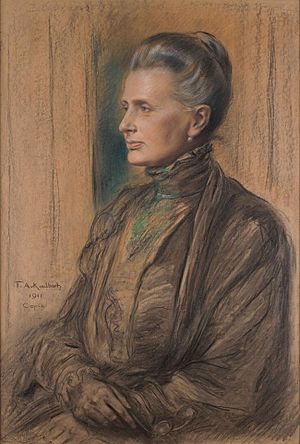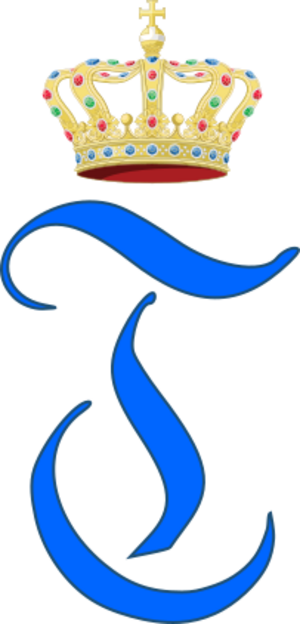Princess Therese of Bavaria facts for kids
Quick facts for kids Princess Theresa |
|||||
|---|---|---|---|---|---|
 |
|||||
| Born | 12 November 1850 Munich |
||||
| Died | 19 December 1925 (aged 75) Lindau |
||||
| Burial | Theatinerkirche | ||||
|
|||||
| House | Wittelsbach | ||||
| Father | Luitpold, Prince Regent of Bavaria | ||||
| Mother | Princess Auguste of Tuscany | ||||
Princess Therese of Bavaria (born November 12, 1850 – died December 19, 1925) was an amazing German princess. She was also a scientist who studied people and cultures (an ethnologist), animals (zoologist), and plants (botanist). She loved to travel and write about her adventures. She also helped people in need.
Therese was the third child and only daughter of Luitpold, Prince Regent of Bavaria, and his wife, Princess Auguste of Tuscany.
Contents
Life of Princess Therese
Therese came from the House of Wittelsbach, one of Europe's most powerful royal families. This family had ruled Bavaria for over 700 years! When Therese was born in Munich, the royal family's power was not as strong as it used to be. They were mostly known for supporting art and building beautiful places.
Childhood and Education
Therese was taught at home with her two brothers, Arnulf and Ludwig. Ludwig later became King Ludwig III, the last king of Bavaria. Therese was very close to Arnulf. They both loved learning about geography.
Therese was very good at languages. She could speak and write in 12 different languages! She also loved plants. Even though she went to some public classes for ladies, most of her learning came from private teachers. She was interested in math, but she really loved natural sciences and learning about faraway lands. She also enjoyed sports like swimming, biking, and mountain climbing.
In 1864, when Therese was 13, her mother passed away. As the only girl in her family, Therese helped manage the household with her aunt. That same year, her cousin Ludwig became King Ludwig II.
Scientific Adventures and Discoveries
Princess Therese made big contributions to understanding where plants and animals live around the world. She worked as a scientist for over 30 years! She was interested in geology (the study of Earth's rocks), botany (plants), anthropology (people and cultures), and zoology (animals). At that time, women were not allowed to study at universities. So, Therese had private tutors to teach her. In 1903, her father, Prince Regent Luitpold, finally allowed women to go to universities.
Travels and Explorations
In 1871, when she was 21, Therese began her many journeys. She first traveled to Italy and Greece. Then she explored other parts of Europe, North Africa, the Middle East, and the Americas.
- In 1888, she visited Brazil.
- In 1893, she explored North America and Mexico.
- In 1898, she toured South America.
Before visiting a country, she would study its history, people, language, and literature. She often traveled with a small group, including a lady-in-waiting. She usually traveled secretly, using a different name. She wrote many books about her trips. In these books, she described the nature of the places she visited. Her first books were published using the name "Th. v. Bayer."
Expedition to Brazil
Princess Therese arrived at the mouth of the Amazon River in Brazil on June 25, 1888. She traveled with a servant who could prepare animal specimens, a lady-in-waiting, and a guard. They went 1000 miles up the Amazon River to Manaus. From there, they traveled up the Rio Negro.
During her journey, Therese collected many plants and animals. These included monkeys, birds, snakes, and butterflies. She hired a local guide who spoke 15 different native languages. With his help, she traded for artifacts made by local people. She collected weapons like spears and arrows, as well as pottery and tools.
After her river journey, she traveled down the coast to Rio de Janeiro. She brought with her a large collection, including some live animals! She also took a train trip through the mountains of the Campos country. There, she collected many mineral samples and visited a mining academy. She continued collecting artifacts throughout her trip along the Rio Santa Maria.
Wherever she could, she visited local museums and botanical gardens. She studied the collections at the National Museum of Brazil in Rio de Janeiro very closely. In Rio, she also met Princess Imperial Isabel of Brazil. Princess Isabel had supported scientific trips and helped create collections that showed off Brazil's gems, minerals, plants, and insects.
After Therese returned to Bavaria, it took her nine years to study everything she had collected in Brazil. Her book, Meine Reise in die Brasilianischen Tropen (My Trip to the Brazilian Tropics), was published in 1897. It was an illustrated travel journal full of information about plants, geology, and animals.
Recognized for Her Work
Princess Therese was highly respected for her scientific work.
- In 1892, she became the first woman to be given an honorary membership in the Bavarian Academy of Sciences and Humanities.
- In the same year, she became an honorary member of the Munich Geographical Society.
- In 1897, she became the first woman to receive an honorary doctorate (a special university degree) from the Ludwig Maximilian University of Munich.
- She was also a member of the Berlin Entomological Society, which studies insects.
- Her collection of artifacts from South America is now part of the State Museum of Ethnology in Munich.
Later Years and Honors
Princess Therese passed away in Lindau.
Honors and Tributes
Princess Therese received many honors for her important work:
 Spain : She was the 629th Dame of the Order of Queen Maria Luisa in Spain.
Spain : She was the 629th Dame of the Order of Queen Maria Luisa in Spain.- She received an honorary doctorate from the Ludwig Maximilian University, Munich.
- She was an honorary member of the Bavarian Academy of Science.
A type of Peruvian lizard, Microlophus theresiae, was named after her to honor her contributions to zoology.
Published Works
Princess Therese wrote several books about her travels and scientific findings:
- Ausflug nach Tunis (Excursion to Tunis). 1880.
- Reiseeindrücke und Skizzen aus Russland (Impressions and Sketches from Russia). Stuttgart 1885.
- Über den Polarkreis (On the Polar Circle). 1889.
- Über mexikanische Seen (On Mexican lakes). Wien 1895.
- Meine Reise in den Brasilianischen Tropen (My Trips in the Brazilian Tropics). Dietrich Remmer, Berlin 1897.
- Einiges über die Pueblo-Indianer. In: Völkerschau, 2 1902, 4-6, 38-42.
- Reisestudien aus dem westlichen Südamerika (Study Trips to the western part of South America). 2 volumes. Berlin 1908.
Films
- Wolfgang Voelker: Prinzessin Therese von Bayern - Forscherin, Sammlerin, Weltreisende. A documentary film from 1997.
See also
 In Spanish: Teresa de Baviera para niños
In Spanish: Teresa de Baviera para niños


